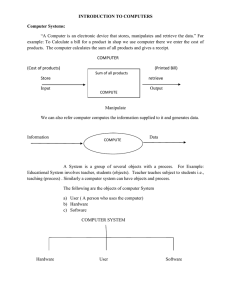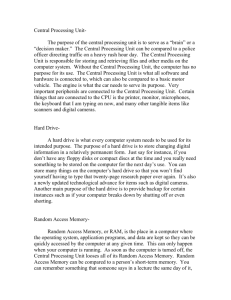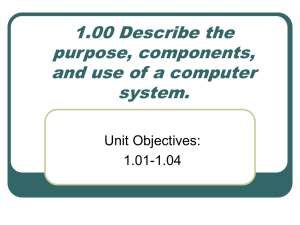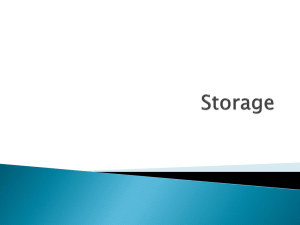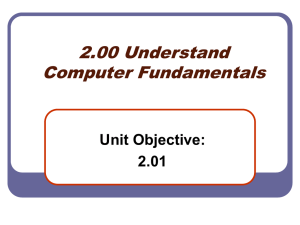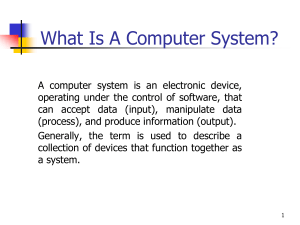Introduction to Computers A beginners approach
advertisement
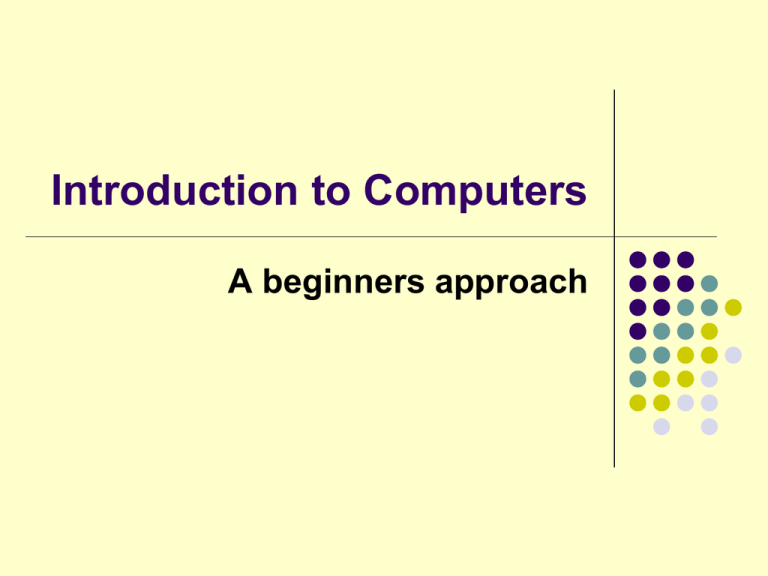
Introduction to Computers A beginners approach Questions ? Computer is an ……………device. A program is a sequence of …………………. Raw facts and figures are called …………. Processed data is called ………………… Keyboard is an …………… device. RAM is ……………………………….. ROM is ……………………………….. Hard Disk is a ………………………………. Computer The word “compute” computer which comes means to from the calculate. Initially computers are mainly used for scientific calculations (research purposes). Presently more than 80% of works done by computers are data processing. Computer is an electronic device that comprises the following components Monitor (output) Speaker (output) System unit (processor, memory…) Printer (output) Storage devices (CD-RW, Floppy, Hard disk, zip,…) Scanner (input) Mouse (input) Keyboard (input) What does a Computer do ? Computers can perform four general operations, which comprise the information processing cycle. Input Process Output Storage Data and Information All computer processing requires data, which is a collection of raw facts, figures and symbols, such as numbers, words, images, video and sound, given to the computer during the input phase. Computers manipulate data to create information. Information is data that is organized, meaningful, and useful. Why Is A Computer So Powerful? Speed: A computer is a very fast device. It can perform in a few seconds, the amount of work that a human being can do in an entire year. Accuracy: The accuracy of a computer is consistently high, and the degree of accuracy of a particular computer depends upon its design. Error can occur in a computer. However, these are mainly due to human and incorrect data. Why Is A Computer So Powerful? Diligence: Unlike human beings, a computer is free from monotony, tiredness and lack of concentration. It can continuously work for hours, without creating any errors. Versatility: A computer can perform a series of operations concurrently. A computer is capable of performing different types of tasks. Why Is A Computer So Powerful? Power of Remembering: A computer can store and recall any amount of information because of its secondary storage capacity. Every piece of information can be retained as long as desired by the user, and can be recalled, as and when required. No I.Q.: A computer possesses no intelligence of its own. Its I.Q. is zero, at least until today. Only the programmer/user can determine what tasks a computer can perform. Why Is A Computer So Powerful? No Feelings: Computers are devoid of emotions. Computers can not make judgements on their own, their judgement is based on the instructions given to them in the form of programs that are written by programmers. Ability to communicate with other computers. How Does a Computer Know what to do? It must be given a detailed list of instructions, called a compute program or software, that tells it exactly what to do. The basic function performed by a computer is the execution of a program. A program is a sequence of instructions, which operates on data to perform certain tasks. What Are The Primary Components Of A Computer ? Input devices. Central Processing Unit (containing the control unit and the arithmetic/logic unit). Memory. Output devices. Storage devices. Input Devices Keyboard. Mouse. The Keyboard The most commonly used input device is the keyboard on which data is entered by manually keying in or typing certain keys. A keyboard typically has 101 or 105 keys. The Mouse Is a pointing device which is used to control the movement of a mouse pointer on the screen to make selections from the screen. A mouse has one to five buttons. The bottom of the mouse is flat and contains a mechanism that detects movement of the mouse. The Central processing Unit The central processing unit (CPU) contains electronic circuits that cause processing to occur. The CPU interprets instructions to the computer, performs the logical and arithmetic processing operations, and causes the input and output operations to occur. It is considered the “brain” of the computer. Memory Memory also called Random Access Memory or RAM (temporary memory) is the main memory of the computer. It consists of electronic components that store data including numbers, letters of the alphabet, graphics and sound. Any information stored in RAM is lost when the computer is turned off. Read Only Memory or ROM is memory that is atttched on a chip that has start-up directions for your computer. It is permanent memory. Amount Of RAM In Computers The amount of memory in computers is typically measured in kilobytes or megabytes. One kilobyte (K or KB) equals approximately 1,000 memory locations and one megabyte (M or MB) equals approximately one million locations A memory location, or byte, usually stores one character. Therefore, a computer with 8 MB of memory can store approximately 8 million characters. One megabyte can hold approximately 500 pages of text information. Output Devices Output devices make the information resulting from the processing available for use. The two output devices more commonly used are the printer and the computer screen. The printer produces a hard copy of your output, and the computer screen produces a soft copy of your output. Categories Of Storage • Magnetic – Floppy disks – Zip disks – Hard drives • Optical – CD-ROM – DVD • Solid state storage devices – USB Key (a very common form of solid state storage) Magnetic Storage Exploits duality of magnetism and electricity Converts electrical signals into magnetic charges Captures magnetic charge on a storage medium Later regenerates electrical current from stored magnetic charge Polarity of magnetic charge represents bit values zero and one 1. Magnetic Drives Magnetic Disk Flat, circular platter with metallic coating that is rotated beneath read/write heads Random access device; read/write head can be moved to any location on the platter Hard disks and floppy disks Cost performance leader for general-purpose on-line secondary storage 1. Magnetic Drives: Storage Capacities Floppy ~ disks 1 MB Hard drives – 500 GB (TB is possible but very rare) ~80 Floppy Disks A floppy disk is a portable, inexpensive storage medium that consists of a thin, circular, flexible plastic disk with a magnetic coating enclosed in a square-shaped plastic shell. Hard Disks Another form of auxiliary storage is a hard disk. A hard disk consists of one or more rigid metal plates coated with a metal oxide material that allows data to be magnetically recorded on the surface of the platters. The hard disk platters spin at a high rate of speed, typically 5400 to 7200 revolutions per minute (RPM). Storage capacites of hard disks for personal computers range from 10 GB to 120 GB (one billion bytes are called a gigabyte). Compact Discs (CD) A compact disk (CD), also called an optical disc, is a flat round, portable storage medium that is usually 4.75 inch in diameter. A CD-ROM (read only memory), is a compact disc that used the same laser technology as audio CDs for recording music. In addition it can contain other types of data such as text, graphics, and video. The capacity of a CD-ROM is 650 MB of data. DVD (Digital Video Disk) DVD-ROM – Over 4 GB storage (varies with format) – DVD- ROM (read only) – Many recordable formats (e.g., DVD-R, DVD-RW; ..) – Are more highly compact than a CD. – Special laser is needed to read them Blu-ray Technology Name Derived from the blue-violet laser used to read and write data. Developed by the Blu-ray Disc Association with more than 180 members. Dell Sony LG Blu-ray Technology Cont. Data capacity Because Blu-ray uses a blue laser(405 nanometers) instead of a red laser(650 nanometers) this allows the data tracks on the disc to be very compact. This allows for more than twice as small pits as on a DVD. Answers Computer is an electronic device. A program is a sequence of instructions. Raw facts and figures are called data. Processed data is called information. Keyboard is an input device. RAM is Random Access Memory. ROM is Read Only Memory. Hard Disk is a secondary storage device. Thank You Murugan R Asst. Professor Dept. of Computer Applications MES College Marampally Aluva – 683 107 www.LSP4YOU.COM +919447177829 murugan@mesmarampally.org mes.murugan@gmail.com

